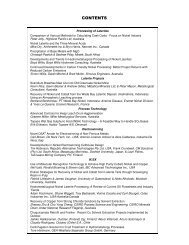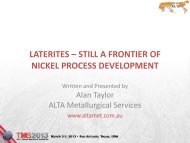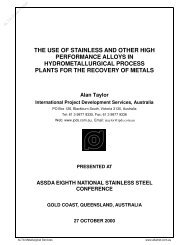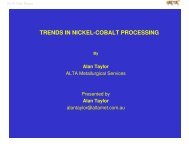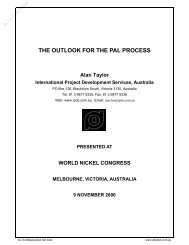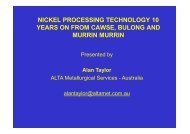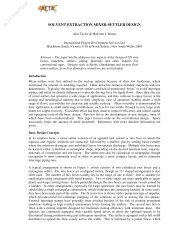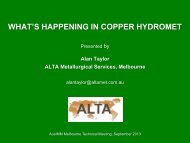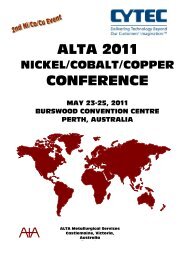review of mixer-settler types and other possible contactors for ...
review of mixer-settler types and other possible contactors for ...
review of mixer-settler types and other possible contactors for ...
Create successful ePaper yourself
Turn your PDF publications into a flip-book with our unique Google optimized e-Paper software.
ALTA Free Paper<br />
Fig. 3: Plan View <strong>of</strong> Reverse Flow Mixer-Settler<br />
Advantages include:<br />
<br />
<br />
<br />
<br />
<br />
The discharge weirs, piping <strong>and</strong> valves are all at one end, thus gaining similar advantages to the<br />
Krebs design over the conventional design.<br />
Some phase separation occurs in the launder.<br />
Provides <strong>for</strong> distribution <strong>of</strong> the dispersion across the <strong>settler</strong> width.<br />
Has similar access <strong>and</strong> operator viewing advantages as conventional design.<br />
Offers some capex advantage over conventional <strong>mixer</strong>-<strong>settler</strong>s.<br />
Disadvantages include:<br />
<br />
<br />
Larger foot print, larger organic inventory <strong>and</strong> longer interstage piping than the Krebs design.<br />
Similar size based disadvantages as the conventionl design.<br />
2.4. VSF (VERTICAL SMOOTH FLOW) MIXER-SETTLER<br />
Proprietary <strong>mixer</strong>-<strong>settler</strong> design developed by Outokumpu. It originated in the nineteen seventies in<br />
the Kokkola cobalt plant in Finl<strong>and</strong>, <strong>and</strong> has been adopted <strong>for</strong> a growing number <strong>of</strong> large scale<br />
copper SX projects since 1995.<br />
Mixing <strong>and</strong> pumping actions <strong>of</strong> the conventional pump-<strong>mixer</strong> are split between a DOP pumping<br />
impeller <strong>and</strong> one or more double helix SPIROK <strong>mixer</strong>s which provide relatively low shear agitation.<br />
The dispersion enters the <strong>settler</strong> via a central vertical uptake <strong>and</strong> flows through a primary<br />
distributing fence, followed by two sets <strong>of</strong> non-jetting picket fences. The <strong>settler</strong> depth gradually<br />
increases towards the weir boxes at the discharge end to decrease velocities <strong>and</strong> reduce<br />
entrainment.<br />
If aqueous recycle is required, it is taken from a header located part way down the length <strong>of</strong> the<br />
<strong>settler</strong>. Organic recycle is taken from the side <strong>of</strong> the organic weir box.<br />
Figure 4 shows a schematic with two mix boxes as well as the DOP bpx.<br />
6



